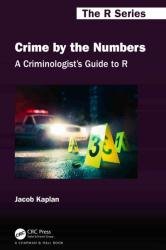A Criminologist's Guide to R: Crime by the Numbers
- Добавил: literator
- Дата: 14-11-2022, 20:08
- Комментариев: 0
 Название: A Criminologist's Guide to R: Crime by the Numbers
Название: A Criminologist's Guide to R: Crime by the NumbersАвтор: Jacob Kaplan
Издательство: CRC Press
Серия: The R Series
Год: 2023
Страниц: 432
Язык: английский
Формат: pdf (true)
Размер: 70.4 MB
A Criminologist's Guide to R: Crime by the Numbers introduces the programming language R and covers the necessary skills to conduct quantitative research in criminology. By the end of this book, a person without any prior programming experience can take raw crime data, be able to clean it, visualize the data, present it using R Markdown, and change it to a format ready for analysis. A Criminologist's Guide to R focuses on skills specifically for criminology such as spatial joins, mapping, and scraping data from PDFs, however any social scientist looking for an introduction to R for data analysis will find this useful.
This book introduces the programming language R and is meant for undergrads or graduate students studying criminology. R is a programming language that is well-suited to the type of work frequently done in criminology - taking messy data and turning it into useful information. While R is a useful tool for many fields of study, this book focuses on the skills criminologists should know and uses crime data for the example data sets.
For this book you should have the latest version of R installed and be running it through RStudio Desktop (the free version). We’ll get into detail on what R and RStudio are soon, but please have them both installed to be able to follow along with each chapter. While you must install both, you only ever need to open RStudio. While R is the actual programming language, RStudio is a program that makes it a lot easier to interact with R than opening up the R application itself. I highly recommend following along with the code for each lesson and then trying to use the lessons learned on a data set that you are interested in.
Key Features:
Introduction to RStudio including how to change user preference settings.
Basic data exploration and cleaning – subsetting, loading data, regular expressions, aggregating data.
Graphing with ggplot2.
How to make maps (hotspot maps, choropleth maps, interactive maps).
Webscraping and PDF scraping.
Project management – how to prepare for a project, how to decide which projects to do, best ways to collaborate with people, how to store your code (using git), and how to test your code.
Table of Contents:
1 A soup to nuts project example 2 Introduction to R and Rstudio 3 Data types and structures 4 Reading and writing Data 5 Mise en place 6 Collaboration 7 R Markdown 8 Testing your code 9 Git 10 Subsetting: Making big things small 11 Exploratory data analysis 12 Regular Expressions 13 Reshaping data 14 Graphing with ggplot2 15 More graphing with ggplot2 16 Hotspot maps 17 Choropleth maps 18 Interactive maps 19 Webscraping with rvest 20 Functions 21 For Loops 22 Scraping tables from PDFs 23 More scraping tables from PDFs 24 Geocoding
Скачать Crime by the Numbers: A Criminologist’s Guide to R
Внимание
Уважаемый посетитель, Вы зашли на сайт как незарегистрированный пользователь.
Мы рекомендуем Вам зарегистрироваться либо войти на сайт под своим именем.
Уважаемый посетитель, Вы зашли на сайт как незарегистрированный пользователь.
Мы рекомендуем Вам зарегистрироваться либо войти на сайт под своим именем.
Информация
Посетители, находящиеся в группе Гости, не могут оставлять комментарии к данной публикации.
Посетители, находящиеся в группе Гости, не могут оставлять комментарии к данной публикации.
